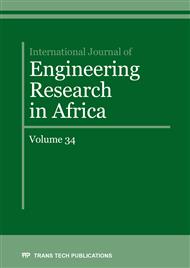[1]
J. Seyed. Optimal production planning. OR/MS Today, (1996). 23(2), 56-59.
Google Scholar
[2]
J. Seyed. Strenthening key links, OR/MS Today, (1998). 25(2), 58-61.
Google Scholar
[3]
S. Dauzère-Pérès, & J. Lasserre. Integration of lot sizing and scheduling decisions in a jobshop. European Journal of Operations Research, (1994). 413–426.
Google Scholar
[4]
S. Dauzère-Pérès, & J. Lasserre. On the importance of sequencing decisions in production planning and scheduling. International Transactions in Operational Research, (2002). 779–793.
DOI: 10.1111/1475-3995.00388
Google Scholar
[5]
S. Dauzère-Pérès. Integrated approach to planning and scheduling production,. Doctoral Thesis, Paul Sabatier University, Toulouse, France (1992).
Google Scholar
[6]
J. Lasserre. An integrated model for job shop planning and scheduling. Toulouse: Management Science (1992, August 1).
Google Scholar
[7]
L. Wang, & W. Shen. Process Planning and Scheduling for Distributed Manufacturing. Springer-Verlag London Limited, London, UK (2007).
Google Scholar
[8]
E. D. Gomez Urrutia. Integrated optimization of planning and scheduling decisions in a logistics chain. Saint Etienne: Doctoral thesis at the national higher school of mines. Specialty: Industrial Engineering (2014).
Google Scholar
[9]
C. Wolosewicz. Integrated Approach to Planning and Production Scheduling. Doctoral thesis at the national higher school of mines. Saint Etienne, Saint Etienne, France (2008, april 22).
Google Scholar
[10]
C. Maravelias, & C. Sung. Integration of production planning and scheduling : Overview, challenges and opportunities. Computers & Chemical Engineering (2009, December 12). Vol. 33(No. 12), p.1919-(1930).
DOI: 10.1016/j.compchemeng.2009.06.007
Google Scholar
[11]
A. Mehra, I. Minis, & J. Proth. Hierarchical production planning for complex manufacturing systems. Advances in Engineering Software (1996). Vol. 26, pp.209-218.
DOI: 10.1016/0965-9978(95)00117-4
Google Scholar
[12]
E. D. Gómez urrutia, R. Aggoune, & S. Dauzère-Pérès. New integrated method to solve the problem of planning and scheduling. 13th Congress of the French Society for Operational Research and Decision Support - ROADEF. Apr, Angers. France (2012).
Google Scholar
[13]
O. Guyon. Coupling Planning and Scheduling: Hierarchical approach and decomposition. Doctoral Thesis, University of Angers, Computer Science Specialty (2010).
Google Scholar
[14]
H. Tempelmeier, & M. Derstroff. Lagrangian-based heuristic for dynamic multi-level multi-item constrained lot sizing with setup times. Management Science, (1996). Vol. 42(No. 5), pp.738-757.
DOI: 10.1287/mnsc.42.5.738
Google Scholar
[15]
W. Roux, S. Dauzère-Pérès, & J. Lasserre. Planning and scheduling in a multi-site environment. Production Planning & Control 10, (1999). Vol. 10(No. 1), pp.19-28.
DOI: 10.1080/095372899233389
Google Scholar
[16]
X. Zhang, & H. Yan. Integrated optimization of production planning and scheduling for a kind of job-shop. International Journal of Advanced Manufacturing Technology (2005). Vol. 26, pp.876-886.
DOI: 10.1007/s00170-003-2042-y
Google Scholar
[17]
R. Sikora, D. Chhajed, & M. Shaw. Integrating the lot-sizing and sequencing decisions for scheduling a capacitated flow line. Computers and Industrial Engineering, (1996). Vol. 30(No. 4), pp.659-679.
DOI: 10.1016/0360-8352(96)00183-0
Google Scholar
[18]
D. Giglio, & R. Minciardi. Integration of production planning and scheduling in manufacturing systems. IEEE International Conference on Systems, Man and Cybernetics (2002), Vol. 5.
DOI: 10.1109/icsmc.2002.1176448
Google Scholar
[19]
C. Timpe. Solving planning and scheduling problems with combined integer and constraint programming. OR Spectrum, (2002). Vol. 24(No. 4), pp.431-448.
DOI: 10.1007/s00291-002-0107-1
Google Scholar
[20]
Y. Keun Kima, K. Parka, & J. Kob. A symbiotic evolutionary algorithm for the integration of process planning and job shop scheduling. Computers & Operations Research, (2003). Vol. 30, pp.1151-1171.
DOI: 10.1016/s0305-0548(02)00063-1
Google Scholar
[21]
H. Jodlbauer. An approach for integrated scheduling and lot-sizing. European Journal of Operational Research, (2006). Vol. 172(No. 2), pp.386-400.
DOI: 10.1016/j.ejor.2004.09.050
Google Scholar
[22]
C. Wolosewicz, S. Dauzère-Pérès, & R. Aggoune. A solving procedure for a general integrated lot sizing and fixed scheduling problem. European Journal of Operational Research (2012).
DOI: 10.1016/j.ejor.2015.01.034
Google Scholar
[23]
C. Wolosewicz, S. Dauzère-pérès, & R. Aggoune. A new approach for solving integrated planning and scheduling problem. In INCOM2006 (2006).
DOI: 10.3182/20060517-3-fr-2903.00112
Google Scholar
[24]
N. Shah, & M. Ierapetritou. Integrated production planning and scheduling optimization of multisite, multiproduct process industry. Computers & Chemical Engineering, (2012). Vol. 37, pp.214-226.
DOI: 10.1016/j.compchemeng.2011.08.007
Google Scholar


